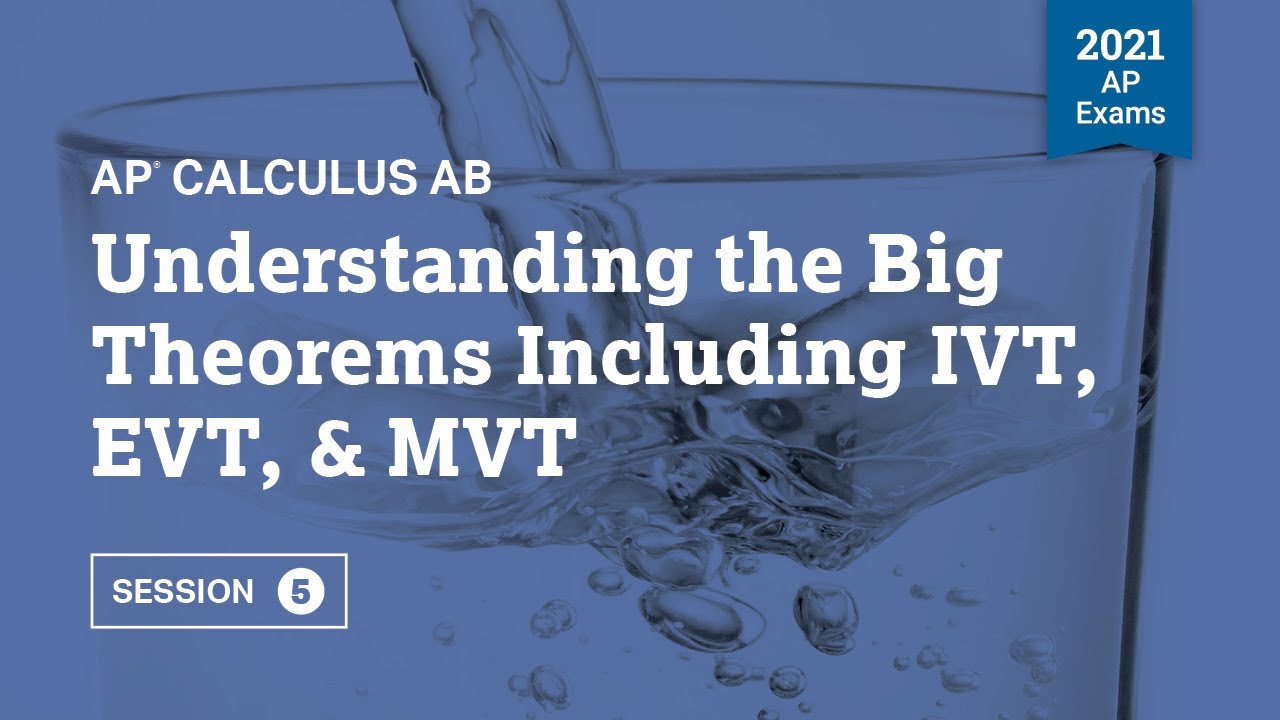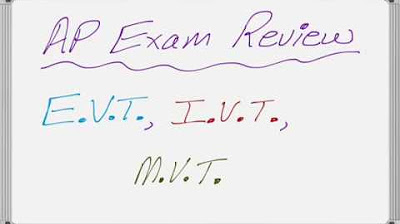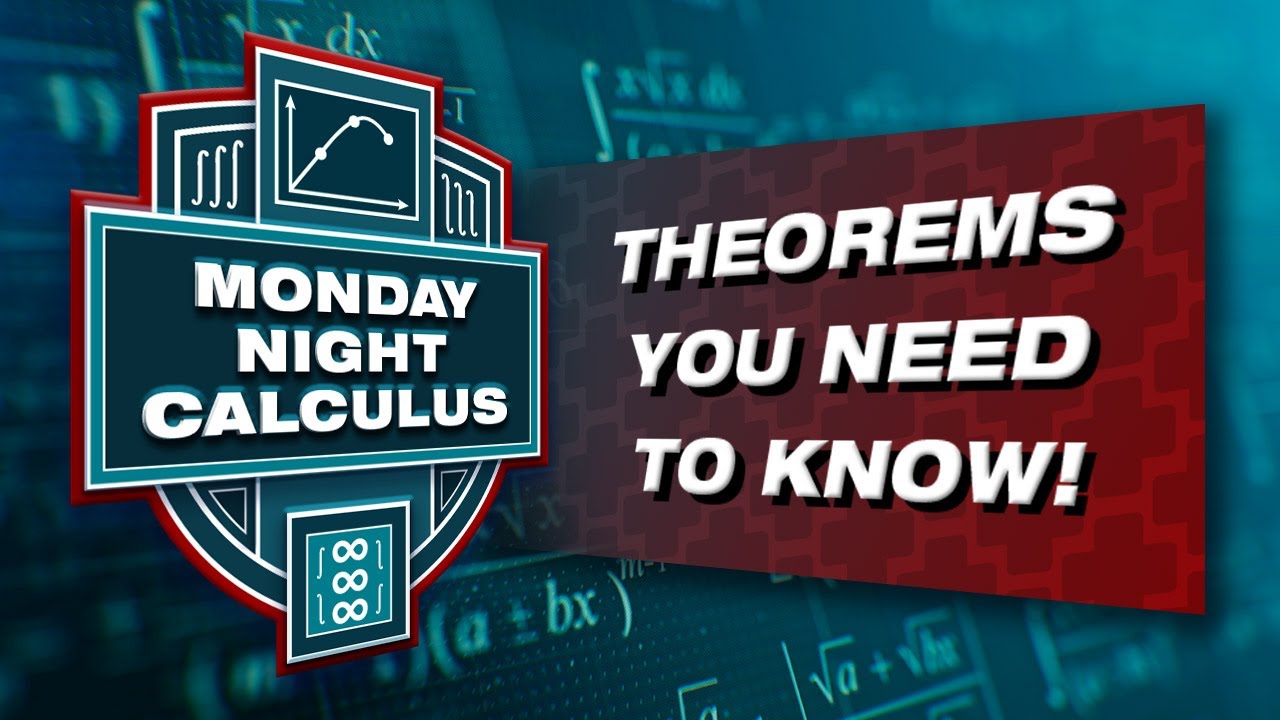2022 Live Review 5 | AP Calculus AB | Focusing on the Big Theorems Including IVT, EVT, & MVT
TLDRIn this engaging video transcript, the hosts, Mark and Verge Cornelius, dive into a detailed discussion on key calculus theorems, specifically focusing on the Intermediate Value Theorem (IVT), the Extreme Value Theorem (EVT), the Mean Value Theorem (MVT), and the Squeeze Theorem. They provide a comprehensive breakdown of these theorems, emphasizing the importance of understanding their conditions and applications. Throughout the session, they work through various problems, using the theorems to find values of functions within given intervals, and highlight the significance of differentiability and continuity in calculus. The hosts also stress the value of visualization in understanding these concepts, encouraging students to plot points and graph functions to gain a deeper insight. The session is not only informative but also includes humor and practical tips for tackling calculus problems, making it an invaluable resource for students preparing for exams or enhancing their mathematical skills.
Takeaways
- 📚 **The Big Theorems**: The focus of the discussion was on the 'big four' theorems in calculus: the Intermediate Value Theorem (IVT), the Extreme Value Theorem (EVT), the Mean Value Theorem (MVT), and the Squeeze Theorem.
- 🔍 **Continuity and Differentiability**: Continuity is a common requirement for many theorems, and differentiability implies continuity, which is crucial for theorems like IVT and MVT.
- 📈 **Intermediate Value Theorem (IVT)**: IVT is used to guarantee the existence of a value for a continuous function within a given interval, ensuring the function will take on all values between its endpoints.
- 📉 **Extreme Value Theorem (EVT)**: EVT states that a continuous function on a closed interval will attain both a maximum and a minimum value.
- 🔢 **Mean Value Theorem (MVT)**: MVT connects the average rate of change of a function over an interval with the instantaneous rate of change at some point within that interval.
- 🏗️ **Squeeze Theorem**: Used to find limits of functions by 'sandwiching' the function between two others with known limits.
- 🤔 **Critical Thinking**: The importance of not just memorizing theorems but understanding their conditions and how to apply them was emphasized.
- 📊 **Visualization**: The speakers highlighted the value of visualizing problems and plotting points or functions to better understand and solve them.
- 🧮 **Practice and Application**: The session included practice problems to apply the theorems, encouraging students to work through them and then check their answers.
- ⏱️ **Time Management**: The speakers reminded students to manage their time effectively, especially during exams where some problems might require more time to digest.
- 📝 **Note-Taking**: Encouragement to take notes, either by writing down theorems or taking screenshots, to aid in remembering and applying the theorems.
- 😄 **Humor in Learning**: The use of humor, like the joke about being afraid of negative numbers, to make the learning process more enjoyable and to help with retention of concepts.
Q & A
What are the 'big four' theorems discussed in the transcript?
-The 'big four' theorems discussed are the Intermediate Value Theorem, the Extreme Value Theorem, the Mean Value Theorem, and the Squeeze Theorem.
What is the Intermediate Value Theorem used for?
-The Intermediate Value Theorem is used to guarantee that a continuous function will take on a value between any two values in its range.
What is the condition required for the Squeeze Theorem to be applicable?
-The Squeeze Theorem requires that the functions involved are continuous and that the function in question is 'squeezed' or bounded between two other functions that converge to the same limit.
What is the Extreme Value Theorem?
-The Extreme Value Theorem states that if a function is continuous on a closed interval, then it must attain both a maximum and a minimum value on that interval.
What is the Mean Value Theorem?
-The Mean Value Theorem states that for a differentiable function on a closed interval, there exists at least one point where the derivative (the instantaneous rate of change) equals the average rate of change over the interval.
What is the significance of differentiability in the context of the Mean Value Theorem?
-Differentiability is significant because it implies continuity, and the Mean Value Theorem requires the function to be continuous on the closed interval and differentiable on the open interval.
What is the role of the calculator in solving the problems discussed in the transcript?
-The calculator is used to perform complex calculations, such as finding derivatives and integrals, evaluating functions at specific points, and solving equations. It is particularly useful for 'calculator active' problems that may require more time to digest.
What is the importance of understanding the conditions for applying the theorems?
-Understanding the conditions is crucial because it ensures the correct application of the theorems. For instance, continuity is a common requirement for many theorems, and differentiability is needed for the Mean Value Theorem.
What is the advice given for avoiding mistakes when calculating limits or derivatives?
-The advice given is to avoid rounding until the final answer is reached, to maintain higher precision during intermediate steps, and to double-check work, especially when dealing with calculations that can be easily misinterpreted, such as those involving negative numbers.
What is the purpose of the joke shared in the transcript?
-The joke about people who are afraid of negative numbers is intended to lighten the mood and provide a moment of humor during the discussion. It also relates to the mathematical content, as it plays on the concept of negative numbers and the avoidance behavior in the context of the Intermediate Value Theorem.
What is the strategy suggested for approaching multiple-choice questions involving theorems?
-The strategy suggested is to first check the conditions required for the theorems, such as continuity or differentiability, and then use those conditions to eliminate incorrect answer choices. It's also advised to visualize the problem and use algebraic manipulation to find the correct answer.
What is the importance of the 'justify' requirement in free-response questions?
-The 'justify' requirement in free-response questions necessitates that the student not only provides an answer but also explains how they arrived at that answer. This often involves using the definition of continuity, applying a theorem correctly, or showing work that leads to the conclusion.
Outlines
😀 Introduction and Theorem Review
The video begins with a casual conversation between Mark and Verge, two educators from different high schools, preparing to discuss various theorems. They briefly mention their previous discussions and emphasize the importance of the Intermediate Value Theorem (IVT), Extreme Value Theorem (EVT), Mean Value Theorem (MVT), and Squeeze Theorem. They also introduce a problem related to the IVT and discuss the conditions required for its application, such as the function being continuous.
🧐 Continuity and Theorems Application
In this paragraph, the educators delve into the specifics of continuous functions and how they relate to the theorems mentioned earlier. They discuss a multiple-choice question that tests the understanding of the IVT and the concept of limits. They also touch upon the idea that a continuous function's limit at a point is equal to the function's value at that point, which is a fundamental concept in calculus.
📚 Practice Problem Walkthrough
The speakers provide a walkthrough of a practice problem involving a function with a mix of polynomial and trigonometric components. They apply the Mean Value Theorem to find instances where the instantaneous rate of change equals the average rate of change over an interval. The process involves calculating derivatives and using a graphing calculator to solve the problem graphically.
🤔 Function Behavior and Theorems
The paragraph focuses on the behavior of a twice differentiable, increasing function over an interval. The educators discuss the implications of differentiability and continuity on the function's slope and concavity. They also explore the Mean Value Theorem's role in finding a tangent line with a specific slope within the interval.
📉 Limits, Continuity, and Inequalities
Here, the discussion revolves around limits, continuity, and inequalities for three different functions, f, g, and h. The educators use the Squeeze Theorem, also known as the Sandwich Theorem, to deduce that the limit of f(x) as x approaches seven is three, given certain conditions about the functions' relationships and limits.
🔍 Extreme Value Theorem and Function Analysis
The educators analyze a piecewise function to determine the conditions under which it attains an absolute maximum value on a closed interval. They reference the Extreme Value Theorem, which states that a continuous function on a closed interval will attain both a maximum and a minimum value. The analysis involves checking the continuity at specific points and understanding the function's behavior.
🧮 Definite Integrals and Function Maxima
This section deals with a function defined as the integral of another function, h(x), and the task of finding the maximum value of this function on a closed interval. The educators perform a candidate's test to find potential maximum points and use the concept of definite integrals to evaluate and compare the function's values at different points in the interval.
📝 Summary of Theorems and Their Usage
The final paragraph summarizes the key takeaways from the video. The educators emphasize the importance of understanding and confirming the conditions of various theorems rather than just their names. They highlight the necessity of visualization, keeping a pencil moving, and brainstorming the theorems to enhance problem-solving skills. They also give a sneak peek into the next session, which will cover applications of integrals.
Mindmap
Keywords
💡Intermediate Value Theorem
💡Extreme Value Theorem
💡Mean Value Theorem
💡Squeeze Theorem
💡Differentiability
💡Continuity
💡Derivative
💡Definite Integral
💡Fundamental Theorem of Calculus
💡Piecewise Function
💡Absolute Maximum and Minimum
Highlights
Mark and Verge discuss the importance of understanding 'big theorems' in calculus, including the Intermediate Value Theorem, Extreme Value Theorem, Mean Value Theorem, and Squeeze Theorem.
They emphasize the necessity of verifying the continuity of a function before applying theorems like the Intermediate Value Theorem.
The speakers use a table of values to explore how many times a function can have a specific y-value within a given interval, highlighting the application of the Intermediate Value Theorem.
Mark and Verge caution against assuming continuity without being explicitly told, which is a common mistake when applying calculus theorems.
The importance of the number line in understanding the behavior of functions and theorems is discussed.
The session includes a practical example of how to apply the Mean Value Theorem to a function involving both polynomial and trigonometric components.
Mark demonstrates how to use a graphing calculator to find derivatives and analyze the behavior of a function, specifically finding where the instantaneous rate of change equals the average rate of change.
The concept of a 'squeeze theorem' or 'sandwich theorem' is introduced as a method to find limits where the function is bounded between two other functions.
Verge explains the conditions under which the Extreme Value Theorem can be applied, focusing on the need for a function to be continuous on a closed interval.
The speakers provide a step-by-step guide to evaluating a piecewise function to find its absolute maximum value within a specified interval.
Mark and Verge discuss the Fundamental Theorem of Calculus in the context of finding the maximum value of an integral-defined function.
The use of the first derivative test to identify relative extrema is demonstrated, with a focus on how changes in the sign of the derivative indicate different types of extrema.
The speakers stress the importance of justifying answers mathematically, especially when applying theorems in problem-solving.
Mark and Verge provide a comprehensive review of the key theorems covered in the session, reinforcing the need to understand and apply them correctly in calculus.
The session concludes with a reminder of the practical applications of these theorems in various calculus problems and the importance of visualizing mathematical concepts.
The speakers outline their plan for the next session, focusing on applications of integrals, including differential equations and particle motion.
Mark and Verge encourage students to practice solving calculus problems both mentally and manually to build a strong foundation in the subject.
Transcripts
Browse More Related Video

2021 Live Review 5 | AP Calculus AB | Understanding the Big Theorems Including IVT, EVT, & MVT

Using IVT, MVT, and EVT

5 | MCQ | Practice Sessions | AP Calculus AB

2022 Live Review 8 | AP Calculus BC | Putting It All Together: Strategies & Tips for the AP Exam

AP Calculus Review Three Theorems You Must Know (EVT, IVT, MVT)

Fall 2023 MNC: Trick or treat - Some important theorems in differential calculus
5.0 / 5 (0 votes)
Thanks for rating: